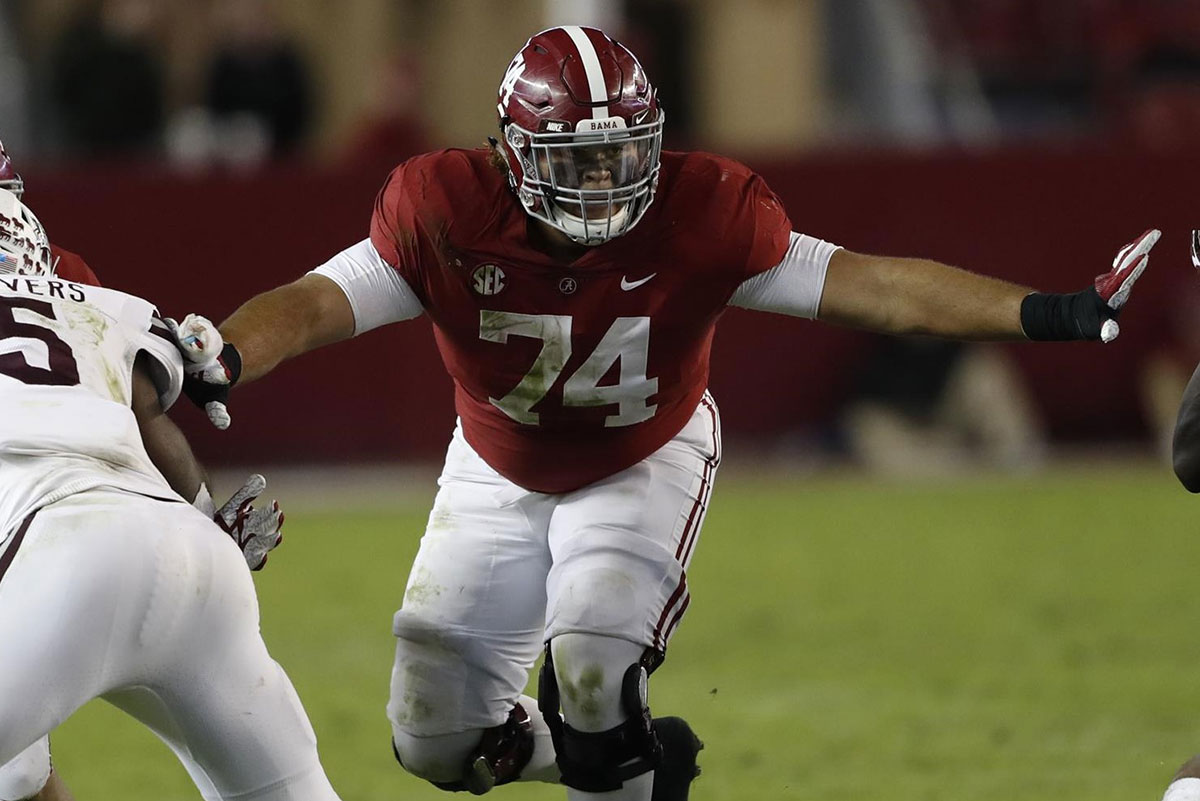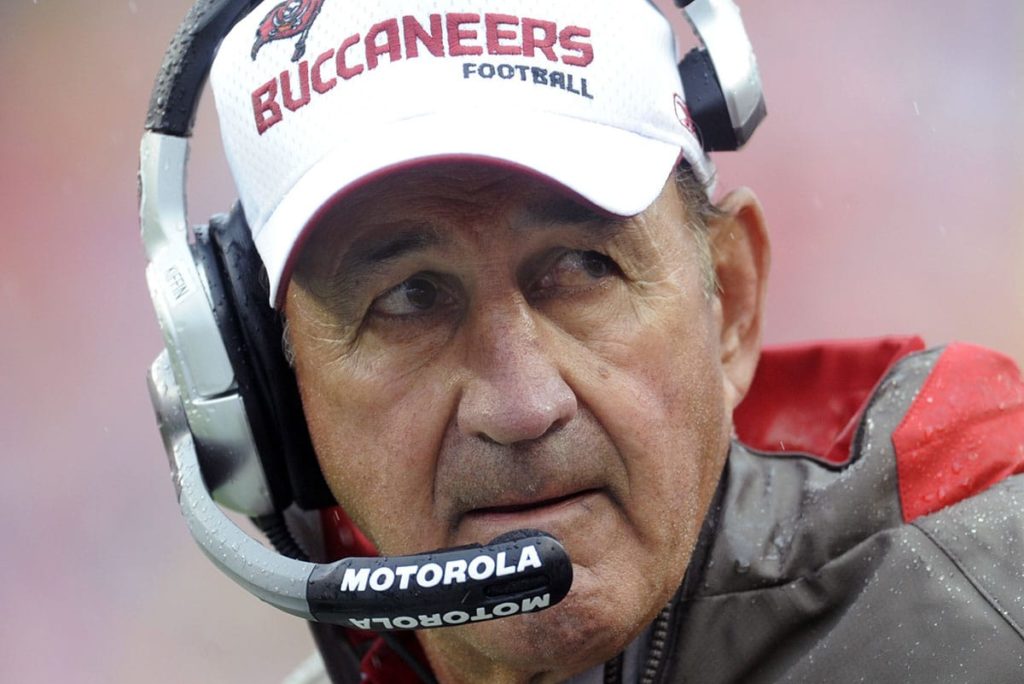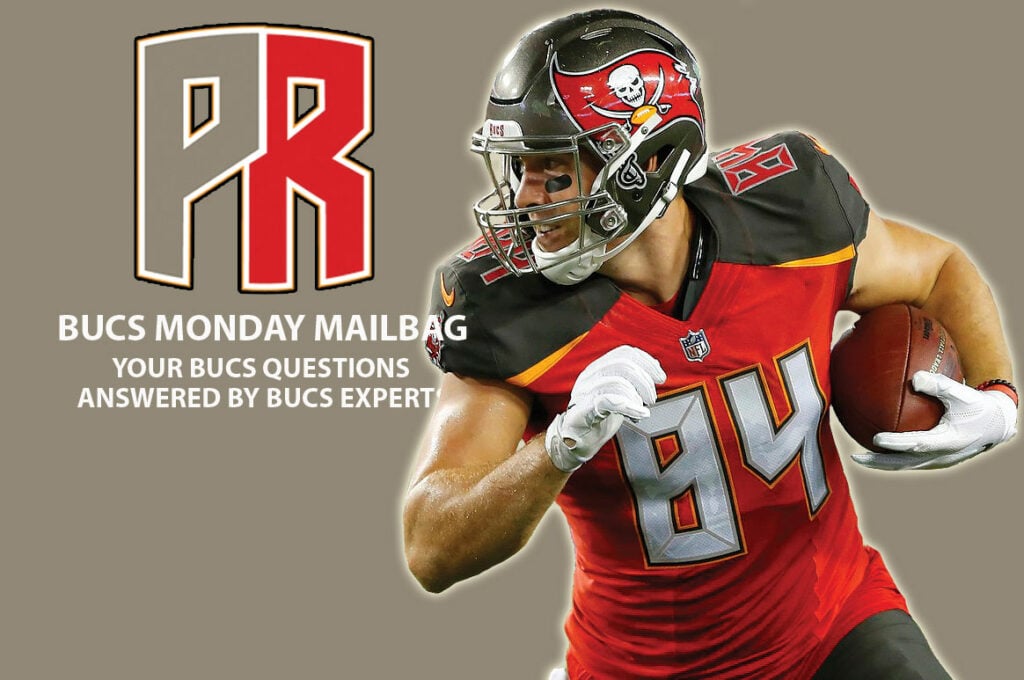I’ve been with Pewter Report for 2.5 weeks now, and one thing I’ve learned in a very short amount of time is that Bucs fans want the offensive line addressed in Round 1, and not a moment later. If the value is there, it’s really difficult to disagree with that perspective.
I’ve scouted ten tackles so far in this class, and by the time the draft has arrived I’ll have looked at almost every game of the following players’ final collegiate season, and several games from earlier in their careers too. You’re going to know these offensive tackle options inside and out, so whenever the team drafts one, you’ll know what to expect.
This tackle class has the potential to be incredible, but there are few positions that require more coaching and refinement in the NFL than this one. Because collegiate offenses are often run-heavy or don’t require pro-style pass sets for their arial attack to operate, projecting tackles to success in the NFL usually requires a healthy amount of risk. Add to that the fact that many of them are going from rarely facing a quality edge pass rusher to facing outstanding talents every week, and it’s a tough position to play well in the NFL without a few years of experience.
To me, OT1 on this list is in a tier of his own, followed by a glut at 2-5 that is going to take me all draft season to really sort out. Is Tristan Wirfs going to measure more like a guard at the Combine? Am I willing to overlook Josh Jones’ lack of facing elite competition on tape, or Mekhi Becton’s unusually low number of true pass sets to put them higher than a more battled-tested, lower ceiling player in Andrew Thomas?
Time will tell. For now, here’s my Pre-Combine ranking of the ten offensive tackles I’ve scouted thus far.
10. Prince Tega Wanogho, Auburn
There are a lot of tools here, but the inconsistency is extremely real. Wanogho has all the physical traits and is a good raw athlete, but he is very much still figuring out how to use all of his gifts functionally as an offensive tackle. He gets a late start on some of his pass sets and can fall behind speed rushers while defending the edge. I’m going to keep studying him, but early impressions are that he’ll need a year or two to develop and a really good offensive line coach before he’s going to see the field in the NFL.
9. Austin Jackson, OT, USC
I’m not sure I get the allure with Jackson in his current projection as a consensus top 40-50 player in the class. His body needs work, he short sets far too often and doesn’t have the power or athleticism to suggest a high ceiling even if those things come along. Jackson is also often a beat late off the snap, causing speed rushers to blow by him and forcing him to abandon proper footwork early in the rep. In the run game he struggles to sustain blocks and consistently was beaten through his gap on zone runs.
Jackson has excellent length and there are flashes of play that are intriguing, but he benefited from playing a lot of fronts that didn’t always have a defender rushing on his outside hip. In games against quality pass rush competition in Bradlee Anae and A.J. Epenesa, Jackson struggled mightily. He’s not as far away as Wanogho, but he’s still going to need time.
8. Saahdiq Charles, LSU
Depending on how bad the character reports on Charles are, he could end up a Round 3 selection or go undrafted. If the latter occurs, it certainly won’t be because of talent, as Charles’ athleticism and flexibility are among the best in the class. After three years as a starter I really hoped he would be more consistent on tape, but Charles still wins on strength and mobility more than hand technique and footwork. He’s a little bit of a project and therefore a big risk even outside of the character concerns, but his high-end flashes at the position are pretty jaw-dropping too.
7. Isaiah Wilson, Georgia
Wilson was such a pleasant surprise on tape. Sure, there are some limitations to his game, but his size, length and power make up for a lot. That will obviously be tough to replicate in the NFL where everyone is bigger and stronger, but Wilson is a mammoth tackle at 6-6, 340. Like Becton, Wilson also moves surprisingly well for his size, showing clean and explosive pass sets and above-average ability to re-direct. He’s careful with his strikes too, showing some nuance in the way he attacks defenders’ hands and reads their pass rush plan.
Where Wilson can fall short is against top-tier speed rushers, as they’ll push him into oversets and open up counters inside. K’Lavon Chaisson cooked him with three inside spins in their matchup this past season. Wilson is also inconsistent with his footwork, at times not gaining enough ground on his first step and failing to establish a half-man relationship with the edge defender. That’ll screw you up fast against the speed he’ll face in the NFL.
He may always have some athletic limitations in pass pro and he needs to clean up some things technically in the run game, but I think he can be an early starting right tackle in the NFL despite just two years of on-field college football experience. More tape study needs to be done here too, as I’ve only studied three games so far (Tennessee, LSU, South Carolina).
6. Lucas Niang, TCU
2019 Niang is not as good as 2018 Niang, and I’m not sure what to make of that just yet. I’m sure that the backpedaling pass sets were a thing he was being told to do in TCU’s offense this past season, but they were a far cry from his beautiful vertical sets in 2018, which he used to shut down Chase Young and Nick Bosa.
Niang is smart, competes hard every snap and has enough physical and athletic tools to be scheme diverse and effective in both the run and pass game. The big questions are the development of his pass set, his ability to play with consistent leverage and a propensity to fall off blocks at all levels at times. Niang at his best is a starting caliber right tackle, but he might need to get into better shape and improve his footwork before sitting atop a depth chart in the NFL.
5. Josh Jones, Houston
To me the top five offensive tackles in this class are extremely obvious, with Jones checking in as my fifth (for now). I don’t think the Houston senior is an elite athlete, but he certainly checks the box in that area while also showing the body control and flexibility that I covet even more at the position.
Jones tape can get kinda of boring because he just doesn’t get beat. Granted, he was rarely tested by Houston’s opponents, but his consistency and physicality as a pass protector stood out against everyone, especially Oklahoma. He was also by far the best offensive lineman at the Senior Bowl in Mobile, dominating most 1v1 matchups and playing lights out in the team periods.
I’m a really big fan of Jones, but two things hold me back from ranking him second or third on this list: 1. Houston’s offense often had him doing some pretty wonky backpedal pass sets, which won’t work in the NFL. And while Jones’ has examples of really pretty pass sets and footwork too, there is some consistency missing there. 2. Jones really didn’t face a lot of NFL-caliber pass rushers this past season, which isn’t his fault at all, but I’m gonna need to look at almost every one of his games before finalizing his grade in order to see him against various types of rushers, fronts and games up front. Right now, I’m only three games in (Washington State, Oklahoma, Cincinnati).
4. Mekhi Becton, Louisville
As long as we’re all comfortable admitting that Mekhi Becton is a big projection to the NFL given the simplistic passing attack he operated in at Louisville as well as the zone-heavy run game, I’ll get on board with the risk takers. Becton may not have taken many true pass sets at Louisville, but the ones he has taken are cash money.
Not only is Becton nimble and smooth on his feet despite being massive, his attention to detail to frame up rushers and establish half-man off the snap is really sound. He’ll be susceptible to speed-counters early on, but his length and athleticism are going to make him a nightmare to corner on, which will eventually lead to him sitting on inside moves. There’s a definite risk with Becton, especially if he lands in a downfield passing attack (like Tampa Bay’s), but I’m putting my chips down on him figuring it out.
P.S. Becton’s grading is almost neck-and-neck with Thomas and Wirfs, but I need to see his testing and get some more All-22 tape of him before I’m ready to make that jump.
3. Andrew Thomas, Georgia
Thomas enjoyed a terrific career at Georgia, but concerns about his process have bumped him down my board a little bit. He’s big, tough and can create movement in the run game, but inconsistencies in his game arose due to playing too high (low man wins!) and not having the feet to match elite speed and bend up the arc. Thomas may need some help against certain matchups in the NFL, but his technique and strength will help him contribute early on. My full scouting report on Thomas is here.
2. Tristan Wirfs, Iowa
I think Wirfs is one of the hardest players in this class to figure out. I want to like him so badly, because his football character, work ethic, frame, athleticism and power all seem absolutely elite for the position. And he hails from Iowa, a program known for their development of NFL-caliber offensive linemen.
But Wirfs’ tape is underwhelming compared to expectations, especially when you consider there is a good chance he’s the top offensive lineman off the board in the 2020 NFL Draft. Wirfs high-end flashes are outstanding, but his footwork in pass protection is wildly inconsistent, from short sets to oversets to almost crossing his feet at times. Wirfs needs to learn to play at full speed and explosiveness all the time, in all of his movements. He’s not aggressive enough in the run or pass game to consistently maximize all his tools, but maybe that confidence hasn’t clicked into his game yet? I don’t know.
He’s a guy that is really hard for me to bet against despite the concerns. I just think he’s going to figure out the technique issues and eventually reach his peak at the next level, but the landing spot and coaching staff he ends up with will be key. It also wouldn’t surprise me if Wirfs’ best football comes at offensive guard, where he can forget the greater attention to detail that offensive tackle requires in regards to footwork and not be as concerned with his lack of elite length on the edge. I think he’ll eventually be the second-best offensive lineman in the draft, but he is a riskier selection than most draft projections would indicate.
1. Jedrick Wills, Alabama
Not only do I believe Jedrick Wills is the clear-cut top offensive tackle in the class, I also believe he’s one of the best overall players in the class as well. Wills possesses all the important traits a top-tier tackle prospect should, as an elite athlete with special footwork and the nastiness and power to finish in all phases of the game. He’s also been battle-tested against the top competition in the country and was still dominant, especially in his 2019 tape. It doesn’t hurt that Alabama’s offense asked him to do a ton of stuff that NFL offenses will ask of him too, from varying his pass sets to a versatile rushing scheme.
Most offensive tackles at the college level aren’t easy to project to the NFL. Wills is. The junior’s lack of elite length is likely the only thing giving teams pause from making him the first offensive lineman off the board in April, and his tape provided ample evidence of the work he can do against quality competition despite shorter arms than most tackles.
Still Need To Watch: Ezra Cleveland, Boise State | Jack Driscoll, Auburn | Ben Bartch, St. Johns | Trey Adams, Washington | Matt Peart, UCONN | Tremayne Anchrum, Clemson | Alex Taylor, South Carolina State
Jon Ledyard is PewterReport.com's newest Bucs beat writer and has experience covering the Pittsburgh Steelers as a beat writer and analyzing the NFL Draft for several draft websites, including The Draft Network. Follow Ledyard on Twitter at @LedyardNFLDraft




